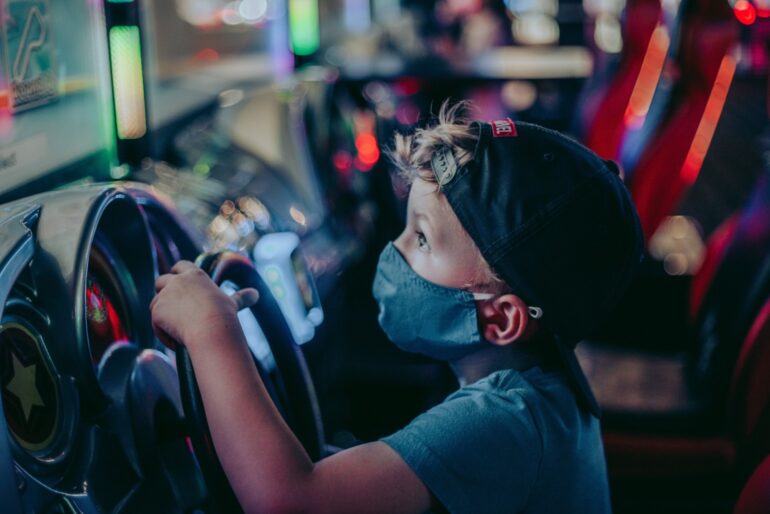We’ve been hearing over and over again that coronavirus is forcing a “new normal.” Well, one big part of this “new normal” is wearing face masks, especially now as businesses (and, in some places, schools) begin to re-open. With over half a million cases confirmed in Illinois, face masks are a huge part of slowing the spread of coronavirus. It’s important that all of us (that includes kids over two) get in the habit of wearing them regularly.
However, lots of grownups have had to adjust to the idea of mask-wearing, so it’s not surprising that our little friends need some help getting used to the idea, too. According to the CDC, 6.7 percent of all confirmed cases were children aged 5-17. Here are a few tips for avoiding mask-meltdowns and making mask-wearing feel a little less scary or strange to kids.
Ease into mask-wearing.
Springing mask-wearing on a tot mere minutes before you enter the doctor’s office or grocery store could be a ticket straight to tantrum town. Instead, have your little one practice wearing a mask at home first. At home, you can introduce mask-wearing in stages: Start with the mask on favorite dolls. Also, do it for a short time. You can start with short mask sessions (even 30 seconds or a minute) and work up to longer stretches. “Okay, while I am getting you the cookies, I need you to wear your mask. Do you want your white mask or the one with stars? Do you want to push the button on the timer? It will ding in just one minute.” (Giving choices is always helpful for kids— as long as you are in control of the choices.)
Make the mask feel special.
Turn masks from a foreign concept into a friendly figure by giving them a say in the process. Let your kids help you shop for masks online and weigh in on the colors and designs they like best. Or, you could order plain masks and let your children decorate them with stickers and paints. Another fun idea? Have your kiddo give her mask a special nickname and personality. Her new mask buddy could join in favorite family activities, like a teddy bear tea party or storytime. As silly as it sounds, this begins to make the mask feel more like a pal… and less like a stuffy face-covering.
Flash a “green light” to encourage mask-wearing.
One of the most effective ways to boost your child’s cooperation, is to flash a “green light” on all the good behavior you want to see with little bits of encouragement. This tells kids, “Yes! Great job! Keep it up!”
‘Gossiping’—praising your child to someone else in a loud whisper that they can overhear—is one way to make that encouragement extra-effective. For example, when your tot puts on her mask without prompting, ‘gossip’ to her dollies, saying “Did you see how Sarah put on her mask all by herself? She’s doing such a wonderful job keeping herself and all of our friends healthy!” Another way to encourage mask-wearing: Every time your child wears the mask for a certain amount of time or puts on the mask without complaint before leaving home, give a check on the hand or put a star sticker on the chart!
Be your child’s masked hero.
To your kids, you’re a superstar… so you’ll show them just how awesome and essential masks are when you wear yours. But along with letting your children see you simply wearing your mask in public, it’s important that you show them how to wear a mask the right way. That means covering your entire nose, mouth, and chin. If you’re wearing your mask around your neck, leaving it loose or open, or allowing your nostrils peek over the top, your mask isn’t able to do its job! Make a special little cape to go with the mask (even loosely tying the arms of a special shirt around the neck can do the trick). Some parents find that kids are happier wearing the superhero mask when they also have a superhero cape.
Demonstrate how to put your mask on and take it off without touching the front of it. Your mask’s job is to filter out the virus… meaning all those germy droplets that you’re trying to avoid may be getting “caught” on the front of your mask (yuck). Then, if you touch your mask, they’re getting all over your fingers! And speaking of germy fingers… make sure your kids see you washing or sanitizing your hands before and after using your mask.
Mask-wearing might feel like a strange new normal to us, but with a little planning, we can help it become second nature to our kids.
For more advice, see the CDC’s guide on how to wear and clean your mask.
More from Better:
- The Executives’ Club of Chicago Women’s Leadership Series on Tapping Women’s Potential in Political Leadership
- It is OK To Not Be OK: 5 Ways to Get the Support You Need
- ‘Chicago Today’ Shares an Inside Look at Curtis Duffy’s New Restaurant, Ever

Dr. Harvey Karp is a world-renown pediatrician and child development expert. His celebrated Happiest Baby/Happiest Toddler books and videos have guided millions of parents and are translated into 30 languages. In 2016, Dr. Karp debuted, SNOO Smart Sleeper, a new class of responsive infant bed designed to add 1-2 hours to a baby’s sleep, quickly soothe crying and to improve safety by preventing dangerous rolling. Dr. Karp is an Assistant Professor of Pediatrics at the USC School of Medicine and a fellow of the AAP. He is an advocate for children’s environmental health and a board member of the Environmental Working Group (EWG).

